Addressing the Gap in Reflective Teaching Practices: A Case Study of an English Lecturer in Non-English Major
DOI:
https://doi.org/10.24903/bej.v7i1.1975Keywords:
Reflective teaching, teacher professional development, non-English major, students’ engagementAbstract
This study explores the implementation of reflective teaching practices by an English lecturer instructing non-English major students and examines its contributions to professional development and classroom engagement. Reflective teaching involves a continuous cycle of self-assessment, adaptation, and improvement, which enables educators to refine their teaching methodologies to better meet students' needs. Using a qualitative case study approach, this research employed multiple data collection methods, including reflective journals, semi-structured interviews with the lecturer and students, and non-participant classroom observations. The findings indicate that reflective teaching significantly enhances lecturer self-awareness, fostering a more adaptive, student-centered instructional approach. By regularly analyzing his teaching methods and incorporating student feedback, the lecturer was able to create a more engaging and inclusive learning environment. Students reported increased motivation, participation, and comprehension as a result of these pedagogical adjustments. Even though the study found some benefits, it also found some problems that can make it hard to use reflective practices consistently. These problems include a lack of time and too much administrative work that should be done by the lecturer. The research underscores the importance of integrating reflective teaching into professional development programs to promote a culture of continuous learning among educators. Additionally, it highlights the need for further studies involving diverse educational settings to explore the long-term impacts of reflective teaching on both instructors and students. By addressing these gaps, future research can contribute to the development of more effective and sustainable approaches for incorporating reflection into higher education teaching practicesReferences
Ayu, S., Dolah, S., & Korompot, C. A. (2022). The Implementation of Reflective Teaching through Students’ Feedback in Teaching English at MTsS YMPI Rappang. Journal of Excellence in English Language Education, 1(4).
Campbell, S., Greenwood, M., Prior, S., Shearer, T., Walkem, K., Young, S., Bywaters, D., & Walker, K. (2020). Purposive sampling: complex or simple? Research case examples. Journal of Research in Nursing, 25(8), 652–661. https://doi.org/10.1177/1744987120927206
Çetin, C., & Bayrakcı, M. (2019). Teacher Professional Development Models for Effective Teaching and Learning in Schools. www.tojqih.net
Chan, C. K. Y., & Lee, K. K. W. (2021). Reflection literacy: A multilevel perspective on the challenges of using reflections in higher education through a comprehensive literature review. In Educational Research Review (Vol. 32). Elsevier Ltd. https://doi.org/10.1016/j.edurev.2020.100376
Dewey, J. (1933). How we think: A restatement of the relation of reflective thinking to the educative process.
Maguire, M., & Delahunt, B. (2017). Doing a Thematic Analysis: A Practical, Step-by-Step Guide for Learning and Teaching Scholars. * (Issue 3). http://ojs.aishe.org/index.php/aishe-j/article/view/335
Miles, M. B., & Huberman, A. M. (2020). Qualitative Data Analysis. 4.
Misra, P. K. (2018). MOOCs for Teacher Professional Development: Reflections, and Suggested Actions. Open Praxis, 10(1), 67. https://doi.org/10.5944/openpraxis.10.1.780
Mukan, N., Yaremko, H., Kozlovskiy, Y., Ortynskiy, V., & Isayeva, O. (2019). Teachers’ Continuous Professional Development: Australian Experience. Advanced Education, 6(12), 105–113. https://doi.org/10.20535/2410-8286.166606
Patnaik, S., & Pandey, S. C. (2019). Case Study Research. In Methodological Issues in Management Research: Advances, Challenges, and the Way Ahead (pp. 163–179). Emerald Group Publishing Ltd. https://doi.org/10.1108/978-1-78973-973-220191011
Schon, D. A. (1983). The Reflective Practitioner: How Professional Think in Action.
Sinap, F., Susilawati, E., & Rosnija, E. (2021). MotivationToward English Language Performance of a Non-English Major Student. Journal of English Education Program, 2(2). https://doi.org/10.26418/jeep.v2i2.46007
Tajeddin, Z., & Aghababazadeh, Y. (2018). Blog-Mediated Reflection for Professional Development: Exploring Themes and Criticality of L2 Teachers’ Reflective Practice. TESL Canada Journal, 35(2), 26–50. https://doi.org/10.18806/tesl.v35i2.1289
Vadivel, B., Namaziandost, E., & Saeedian, A. (2021). Progress in English Language Teaching Through Continuous Professional Development—Teachers’ Self-Awareness, Perception, and Feedback. Frontiers in Education, 6. https://doi.org/10.3389/feduc.2021.757285

Downloads
Published
How to Cite
Issue
Section
License
Copyright (c) 2025 Eni Uswatun Hasanah, Bibit Suhatmady, Yuni Utami Asih, Ventje Jany Kalukar, Weningtyas Parama Iswari, Maria Teodora Ping

This work is licensed under a Creative Commons Attribution 4.0 International License.
Authors retain copyright and grant the journal right of first publication with the work simultaneously licensed under a Creative Commons Attribution 4.0 International License that allows others to share the work with an acknowledgment of the work's authorship and initial publication in this journal.



